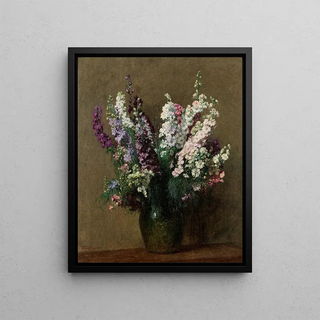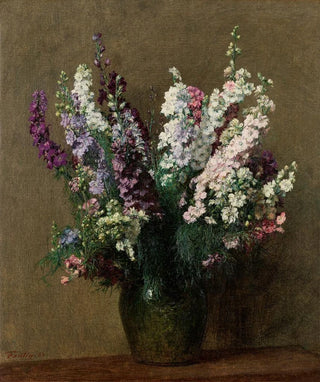Art print | Pieds d'alouette - Henri Fantin-Latour Source: Reproduction | Pieds d'alouette - Henri Fantin-Latour


View from behind

Frame (optional)
Reproduction Pieds d'alouette - Henri Fantin-Latour – Engaging Introduction
The art print "Pieds d'alouette" by Henri Fantin-Latour is a work that embodies delicacy and harmony with nature. In this composition, the artist manages to capture the very essence of flowers, revealing their fleeting beauty and fragility. Immersing oneself in this floral universe, the viewer is invited to contemplate a scene where light dances on the petals, creating an atmosphere that is both serene and poetic. Fantin-Latour, often associated with the Impressionist movement, transcends simple floral representations to offer a true sensory experience, where every shade of color and every meticulous detail are carefully orchestrated.
Style and uniqueness of the work
The uniqueness of "Pieds d'alouette" lies in Fantin-Latour's technical mastery, which combines realism and sensitivity. His style is characterized by a palette of delicate colors, where pastel tones subtly blend to bring flowers to life. The forms are both precise and fluid, demonstrating an in-depth observation of nature. Shadows and lights are skillfully used to create depth, making the flowers appear almost alive. This work does not merely depict the external beauty of nature; it also evokes emotion, a silent contemplation that invites the viewer to lose themselves in the fleeting beauty of these flowers. The composition, well balanced, highlights each element without ever overloading the whole, thus revealing Fantin-Latour's artistic philosophy, which advocates simplicity and elegance.
The artist and his influence
Henri Fantin-Latour, born in 1836 in Grenoble, is a painter who made his mark on his era through his unique approach to nature and portraiture. Raised in an artistic environment, he developed a style that is his own, blending influences of realism and romanticism. Fantin-Latour is also recognized for his ability to capture the spirit of his time, incorporating elements of everyday life and intimate scenes into his works. His friendship with emblematic figures of the Impressionist movement, such as Claude Monet and Édouard Manet,

Matte finish

View from behind

Frame (optional)
Reproduction Pieds d'alouette - Henri Fantin-Latour – Engaging Introduction
The art print "Pieds d'alouette" by Henri Fantin-Latour is a work that embodies delicacy and harmony with nature. In this composition, the artist manages to capture the very essence of flowers, revealing their fleeting beauty and fragility. Immersing oneself in this floral universe, the viewer is invited to contemplate a scene where light dances on the petals, creating an atmosphere that is both serene and poetic. Fantin-Latour, often associated with the Impressionist movement, transcends simple floral representations to offer a true sensory experience, where every shade of color and every meticulous detail are carefully orchestrated.
Style and uniqueness of the work
The uniqueness of "Pieds d'alouette" lies in Fantin-Latour's technical mastery, which combines realism and sensitivity. His style is characterized by a palette of delicate colors, where pastel tones subtly blend to bring flowers to life. The forms are both precise and fluid, demonstrating an in-depth observation of nature. Shadows and lights are skillfully used to create depth, making the flowers appear almost alive. This work does not merely depict the external beauty of nature; it also evokes emotion, a silent contemplation that invites the viewer to lose themselves in the fleeting beauty of these flowers. The composition, well balanced, highlights each element without ever overloading the whole, thus revealing Fantin-Latour's artistic philosophy, which advocates simplicity and elegance.
The artist and his influence
Henri Fantin-Latour, born in 1836 in Grenoble, is a painter who made his mark on his era through his unique approach to nature and portraiture. Raised in an artistic environment, he developed a style that is his own, blending influences of realism and romanticism. Fantin-Latour is also recognized for his ability to capture the spirit of his time, incorporating elements of everyday life and intimate scenes into his works. His friendship with emblematic figures of the Impressionist movement, such as Claude Monet and Édouard Manet,






